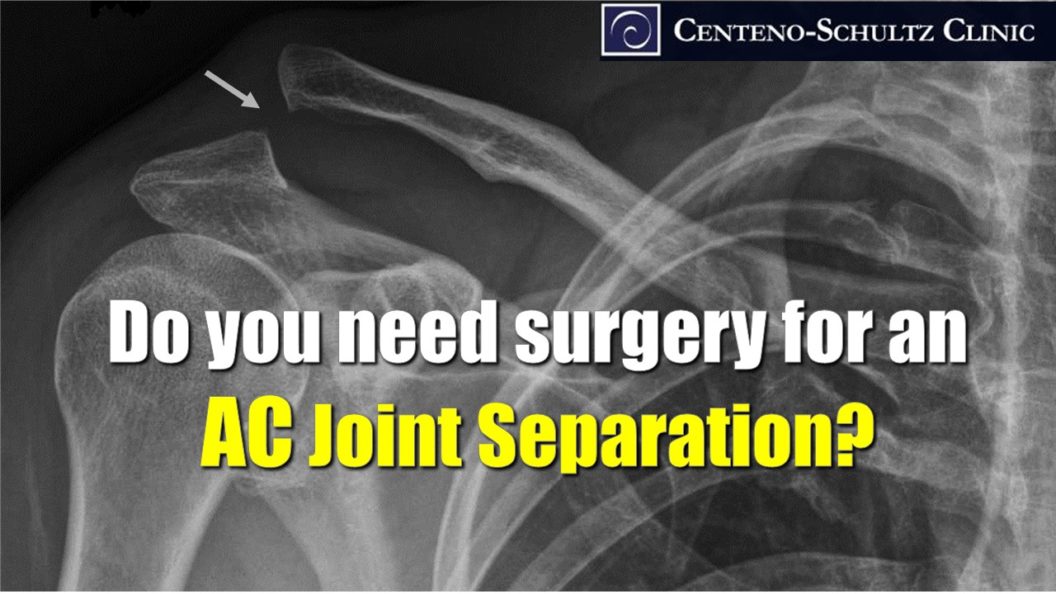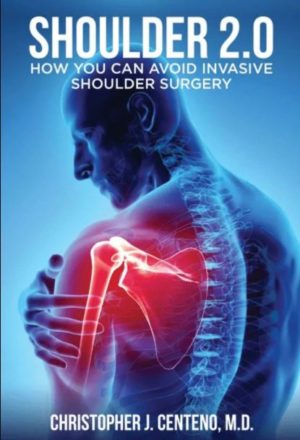An AC joint separation, or dislocation, in the shoulder can occur as a result of an injury. For example, our own Dr. Centeno experienced a separation of his AC joint 30 years ago in a motorcycle crash. Even at that time, he opted against surgery, and based on current research, there’s a good chance that if you have a separation of your AC joint that you should, too.
The AC Joint and the Surgery to “Repair” It
Resting atop the shoulder is a joint called the acromioclavicular (AC) joint. Place your fingers on your collarbone and follow it out toward the top of your shoulder. Just before reaching the shoulder, you’ll come to a small protrusion in the bone. This is the AC joint. Slide your fingers beyond the AC joint, and you will be able to feel your shoulder bone (i.e., the acromion). For those with an interest in medical terminology, the AC joint is the intersection between the acromion (acromio-) and the clavicle (clavicular), hence, acromioclavicular joint. So an AC joint separation occurs when the acromion separates from the clavicle at the joint.
When the AC joint becomes separated during an injury, in most cases conservative measures and giving it time will allow it to heal. When the separation is more severe (levels III–V), involving not just the bone but also tears in the supporting ligaments, a physician may recommend surgery, which typically involves repositioning or reconstructing ligaments and even removal of a piece of the clavicle and then bolting the joint together to attempt to provide joint stability. Unfortunately, shoulder separation surgery disrupts movement and the AC joint’s normal flexibility, pain can continue, and recovery time can be lengthy.
So is AC separation surgery a good idea for those higher-grade AC injuries? One study found that surgery may actually be no better than conservative management, even for high-grade shoulder separations.
Surgery vs. Conservative Management for AC Joint Separation
The study compared the outcomes of patients who underwent surgery for AC joint separation to patients who simply used conservative nonoperative management on their affected shoulder. Both groups had high-grade (the most severe type) AC joint separation. At the end of the study period, there were no significant differences between the two groups, either clinically or functionally. There were some major differences, however. The nonsurgical group not only had fewer infections and complications during their healing process, but they were also able to return to work faster than the group that underwent AC joint separation surgery. It’s important to note that there are many other studies on AC joint separation surgery that have very similar results. So this is yet another one of those shoulder surgeries that seems to serve no real purpose.
Another Questionable Shoulder Surgery
Another shoulder surgery, which we discussed a few months ago, that seems questionable is shoulder decompression surgery. This one involves removing bone spurs, which typically form to protect a joint or provide more stability to the joint, and releasing ligaments from structures they are believed to be damaging or putting too much pressure on—this called shoulder impingement.
Unfortunately, this surgery, as we discussed, comes with its own list of problems, including creating shoulder instability (when those stabilizing bone spurs are lopped off and ligaments are released) and not actually relieving pain. And just like with the shoulder separation surgery, research shows that shoulder decompression surgery fares no better than no surgery. Take a look at Dr. Centeno’s video below on AC joint decompression surgery complications:
So do you need surgery for an AC joint separation in the shoulder? In our experience and based on the research to date, we have to say no, not even for one of those high-grade separations, such as the one Dr. Centeno experienced over 30 years ago, which healed fully without surgery.

